Text
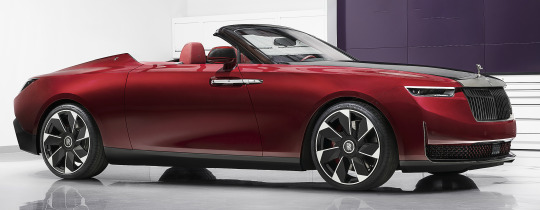

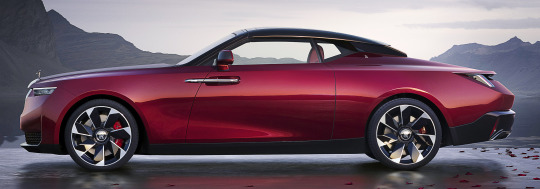


Rolls-Royce Droptail La Rose Noire, 2024. Created to a client commission by Rolls-Royce Coachbuild, inspired by the Black Baccara rose, an intense, velvet-like flower that originates in France and is beloved by the mother of the commissioning family. Following on from the Sweptail and Boat Tail, the new droptail will be built in an edition of 4 cars, each telling "a unique and personal story that reflects the ambition, visions and taste patterns of its commissioning client"
#Rolls Royce#Rolls-Royce Droptail La Rose Noire#Rolls-Royce Droptail#coachbuilt#Rolls-Royce Coachbuild#limited edtion#open roof#luxury car#2024#new cars#Black Baccara rose
297 notes
·
View notes
Text
Rolls-Royce unveils La Rose Noire Droptail: the first droptail coachbuild commission
Rolls-Royce Motor Cars is privileged to present Rolls-Royce La Rose Noire Droptail, a dark, daring and dramatic coachbuilt masterpiece. Continue reading Untitled
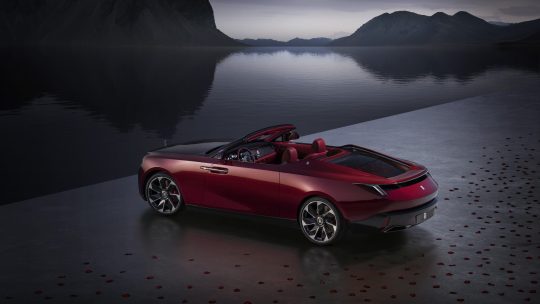
View On WordPress
#automotive#coachbuild#La Rose Noire Droptail#news#Press release#Rolls-Royce#Rolls-Royce La Rose Noire Droptail
2 notes
·
View notes
Text







“Superstar”
1959 Rolls Royce Silver Cloud 🇬🇧
Tony Bennett. John Lennon. Elvis Presley. Frank Sinatra. These are just some of the names to whom Rolls-Royce dealers issued invoices for Silver Clouds. By the end of production in 1965, the Silver Cloud III’s £5500 list price would have bought you a seven-bedroom house, or ten Minis with almost change for an eleventh. By no standards was this a cheap car, and yet its clientele were changing. In a gradually easing social environment, the Silver Cloud had begun to appeal to the self-made owner-driver. And its replacement, the Silver Shadow, was deliberately tailored towards this market, with its relatively low-slung styling and monocoque construction being the height of modernity by Rolls-Royce standards. The Silver Cloud would therefore be the company’s final separate-chassis saloon, and thus the last to offer significant appeal for coachbuilders.
Available since June 2’nd for “No Limits” and “All Inclusive” tiers exclusively.
Model with HQ interior, open/close doors and functional light.
Go and join my Patreon!
#the sims 4#sims 4#sims4#sims4car#the sims 4 cc#the sims 4 custom content#thesims4cars#the sims 4 cars#sims4vehicles#the sims
29 notes
·
View notes
Photo
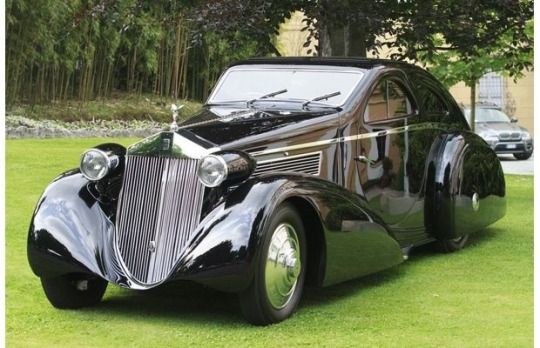



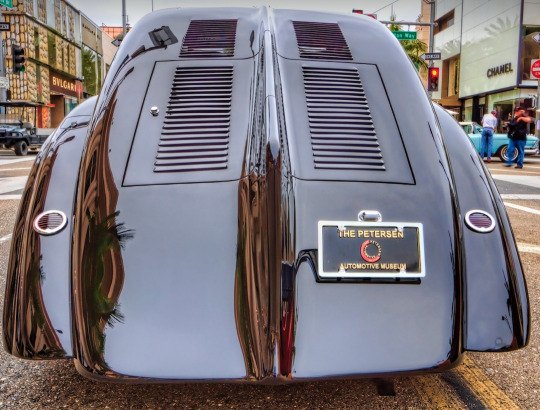
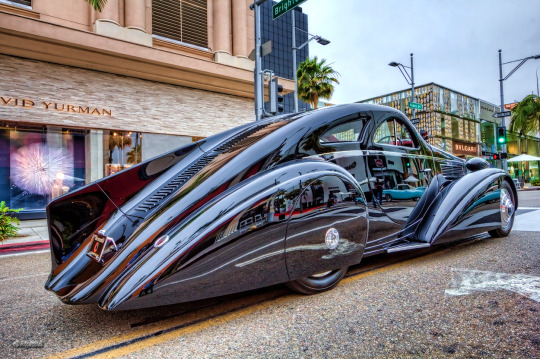



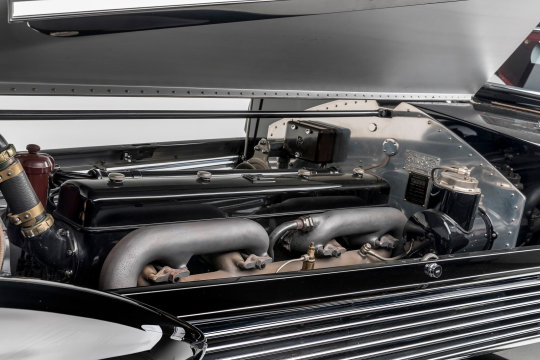
Rolls-Royce Phantom I Jonckheere Coupe
The first Rolls-Royce Phantom — then called the New Phantom, presently called the Phantom I — was introduced in 1925 in response to competition from European luxury marques like Hispano-Suiza and Isotta Fraschini and from premium American automakers like Packard and Pierce-Arrow. Based on the chassis of the outgoing 40/50 model, now known as the Silver Ghost, the Phantom introduced Rolls-Royce's first overhead valve engine and four-wheel brakes (although some sources say front brakes were introduced in late production Silver Ghosts). The OHV engine was taller than the sidevalve motor. That affected styling. The bodies coach built for the Phantom I had higher hoods, radiator shells and cowls.
In 1934, an as-yet-unidentified owner took the Phantom to the Jonckheere body company near Roeselare, Belgium to be rebodied. Though Henri Jonckheere built his first luxury automobile in 1902, the company had transitioned to making mostly bus and coach bodies by the 1930s. It still exists today as VDL Jonckheere.t’s not known who designed it, but Jonckheere built a radically different coupe body. Some say it was inspired by the aero designs of stylists Jacque Saoutchik and Joseph Figoni — but, to my eyes, it’s not nearly as elegant and flowing as their work. The squarish Rolls-Royce grill was retained, but it was sloped back to give the tall grill a more streamlined look. It is perhaps the only classic era Rolls-Royce whose grill is not vertical. To say the least, the car is a bit controversial with traditional Rolls-Royce enthusiasts. The windshield is also steeply raked. Bullet headlights and very long and flowing fenders continue the streamlined theme, but the car is so massive it’s hard for me to call it sleek. To finish off the aero look, Jonckheere put a big tailfin down the length of the middle of the trunk lid. Such fins were popular with European coachbuilders in the 1930s and you can see them on Bugattis, Delahayes and other custom-bodied cars of the era. Designer Raymond Loewy added one to his customized 1939 Lincoln Continental. Of course, the Rolls��� most distinctive features are its large rear-hinged round doors, which allow ingress for both front and rear passengers. Because of the odd door shape, the side windows are split vertically and open up like a scissors as they retract into the doors. Round fender skirts for the rear wheels echo the shape of the doors.
The car is almost 20-feet long and finished in dark black. It’s a big, almost ominous looking vehicle that would be at home in a Batman movie, driven by the villain. It’s not a very practical car. With ponderous weight and no power assist, the steering is difficult, particularly at low speed. The non-synchro transmission needs to be double clutched and, even though the car features Rolls-Royce’s servo-assisted mechanical brakes, the weight makes it hard to stop. The large turning radius, low ground clearance and extended rear end make maneuvering the vehicle difficult. The steeply sloping fastback roofline forces rear passengers to slouch. There is no back window to speak of, just louvers, so visibility isn’t the best. To make the most of the limited trunk space, there is a set of fitted luggage.
#Rolls-Royce Phantom I#Hispano-Suiza#Isotta Fraschini#Packard#Pierce-Arrow#Jonckheere#Lincoln Continental
249 notes
·
View notes
Text
Best Vintage Cars
The Allure of Vintage Cars: A Journey Through Time and Automotive Craftsmanship

Vintage cars are more than just vehicles; they are a celebration of automotive history, craftsmanship, and timeless design. These classic cars evoke nostalgia for a bygone era, reflecting the innovation and artistry that defined early motoring. From the elegance of pre-war automobiles to the muscle cars of the 1960s, vintage cars represent a passion for engineering and a love for unique, hand-crafted machines.
This article explores the world of vintage cars, their significance, the different eras they represent, and why these beautiful machines continue to capture the hearts of collectors and enthusiasts today.
What Defines a Vintage Car?
The term "vintage" often refers to cars that were manufactured between the 1910s and the 1930s, although the exact definition can vary depending on the region or collector's club. In general, vintage cars are those that are at least 30 years old, and they can be further categorized into different eras:
Brass Era (1885–1915): These are some of the earliest cars, named after the brass fittings and fixtures used in their design. They often have exposed radiators, gas lamps, and large, spoked wheels.
Vintage Era (1919–1930): This period saw the rise of closed-body cars (those with roofs) and significant advancements in car production, most notably with the mass-production techniques pioneered by Henry Ford.
Classic Era (1930–1970s): While not technically considered vintage by purists, classic cars—especially those from the 1930s to the 1970s—are highly sought after for their design, power, and cultural significance. This era includes pre- and post-war models as well as the iconic muscle cars of the 1960s.
Each of these eras contributes a distinct chapter to the story of automotive evolution, from early experimentation to the development of powerful, stylish machines.
The Evolution of Automotive Design
The design and technology of vintage cars reflect the era in which they were made. Cars from the early 20th century were often hand-built, with intricate detailing and a focus on luxury and craftsmanship. As industrial processes improved, cars became more affordable, and automakers began to focus on performance and innovation.
The Brass Era: The Dawn of Motoring
The Brass Era, from the late 19th century to the early 20th century, marks the birth of the automobile industry. Cars like the Ford Model T, introduced in 1908, revolutionized personal transportation by making cars affordable to the masses. Before that, cars were largely bespoke creations, crafted by skilled engineers and craftsmen. Brands like Rolls-Royce, Cadillac, and Packard became synonymous with luxury and elegance during this time.
The early cars were often open-top vehicles with large, brass fittings such as radiators, headlights, and horns. These cars required manual cranking to start and often featured wooden frames and bodies, giving them a unique aesthetic appeal. Despite their simplicity compared to modern cars, these vehicles were groundbreaking in their design and engineering.
The Vintage Era: The Rise of Style and Sophistication
The 1920s and 1930s, often referred to as the Vintage Era, saw car manufacturers refining their designs and offering more powerful and luxurious models. This period is when cars truly began to transition from functional machines to symbols of status and wealth.
Automobiles like the Rolls-Royce Phantom, Bentley 4½ Litre, and Bugatti Type 35 exemplified the blend of performance, style, and elegance that defined the era. Innovations in suspension, engine design, and aerodynamics began to make these cars faster, smoother, and more comfortable to drive.
During this time, design became more focused on aesthetics, with streamlined shapes, luxurious interiors, and increased attention to detail. Coachbuilders such as Pininfarina, Zagato, and Mulliner worked with manufacturers to create custom, hand-built bodies for wealthy clients, each car becoming a one-of-a-kind masterpiece.
The Classic Era: The Birth of Iconic Automobiles
The post-World War II era, particularly the 1950s and 1960s, brought about the rise of the classic car era, with manufacturers producing some of the most iconic cars in history. This period saw the birth of legendary American muscle cars like the Ford Mustang, Chevrolet Corvette, and Pontiac GTO. These cars were built for speed and performance, capturing the excitement and freedom of the open road.
On the other side of the Atlantic, European manufacturers like Ferrari, Jaguar, and Aston Martin were creating cars that combined performance with unparalleled beauty. The Ferrari 250 GTO, Jaguar E-Type, and Aston Martin DB5 became symbols of automotive excellence, admired for their sleek designs and powerful engines.
The classic era also saw advancements in automotive technology, such as disc brakes, independent suspension, and more efficient engines. These innovations made cars not only faster but also safer and more reliable, increasing their appeal to both collectors and drivers.
Why Vintage Cars Are Still Relevant Today
In a world dominated by modern cars loaded with advanced technology, vintage cars still hold a special place in the hearts of many. Several reasons contribute to their enduring appeal:
1. Timeless Design
Vintage cars are celebrated for their timeless design. Unlike modern cars, which are often subject to rapidly changing trends, the design principles of vintage cars are rooted in elegance, craftsmanship, and simplicity. Whether it’s the sleek lines of a 1950s Porsche or the imposing grille of a 1930s Bentley, vintage cars have an aesthetic appeal that transcends time.
2. Mechanical Simplicity
While modern cars are packed with computers and electronic systems, vintage cars are admired for their mechanical simplicity. Enthusiasts appreciate the hands-on nature of maintaining and restoring these vehicles. Many vintage cars can be worked on with basic tools, making them a rewarding project for hobbyists and collectors who enjoy tinkering with engines and components.
3. Historical Significance
Each vintage car tells a story, representing a specific time in automotive history. Whether it’s a 1930s Mercedes-Benz from the pre-war era or a 1960s Chevrolet Camaro that captured the spirit of American muscle cars, these vehicles serve as living history, offering a glimpse into the design, technology, and culture of their time.
4. Investment Potential
In recent years, vintage cars have become a popular investment for collectors. Classic models, particularly those that are rare or have historical significance, have seen significant appreciation in value. Cars like the Ferrari 250 GTO or the Aston Martin DB5 are now worth millions, making them highly coveted pieces in the world of automotive collectibles.
5. Sense of Community
Owning a vintage car often comes with a sense of belonging to a passionate community. Vintage car enthusiasts gather at car shows, rallies, and auctions to celebrate their shared love for these machines. Clubs and associations dedicated to specific makes or models offer a space for enthusiasts to exchange knowledge, share restoration tips, and enjoy their cars together.
Restoring and Maintaining Vintage Cars
Restoring a vintage car is a labor of love, requiring time, dedication, and often a significant financial investment. Whether it’s sourcing rare parts, rebuilding engines, or refinishing interiors, the process can be both challenging and rewarding.
One of the main challenges of restoring vintage cars is finding original parts. Many manufacturers no longer produce parts for older models, so collectors often rely on specialist suppliers, salvage yards, or custom fabrication. Authenticity is key in restoration, with original parts and materials enhancing the car’s value and historical integrity.
Maintaining a vintage car also requires careful attention to detail. Regular maintenance, such as changing the oil, inspecting brakes, and checking the electrical system, is essential to keeping the car running smoothly. While vintage cars may not be as reliable as modern vehicles, their mechanical nature makes them easier to repair for those with the right knowledge and skills.
Conclusion
Vintage cars represent more than just transportation; they are a celebration of history, design, and engineering. From the earliest Brass Era automobiles to the classic muscle cars of the 1960s, these vehicles evoke a sense of nostalgia and admiration for a time when cars were not just mass-produced machines but works of art.
Whether it’s for their timeless beauty, historical significance, or the thrill of restoration, vintage cars continue to captivate collectors, enthusiasts, and drivers alike. As symbols of a bygone era, they remind us of the artistry and craftsmanship that once defined the automotive industry, ensuring their place in history for generations to come.
5 notes
·
View notes
Text

1929 Duesenberg Model J Convertible Victoria Coachwork by Rollston
Duesenberg Model J and Model SJ
Fred Duesenberg was a master of creating engines and was a creative designer. He had a talent for conceiving new ideas and ways of doing things. The engines he constructed were beautiful, mechanically sound, and advanced. E.L. Cord gave him one task: 'Create the best car in the world.' This was a very tall order and came at a very difficult time in history. The onset of the Great Depression and the Stock Market crash was just around the corner. Competition in the luxury car segment was fierce and involved all facets of the automobile. The cylinder wars that began in the 1920s and continued into the 1930s had marque's trying to outdo each other on the bases of its engine output, the number of cylinders, and the speed of their ultra-luxury automobiles. Styling continued to be very important and often outsourced to the greatest designers and coachbuilders of the time. Maruqee's such as Cadillac, Packard, Rolls-Royce, Hispano-Suiza, Isotta Fraschini, Bugatti, and others were all trying to out-do each other and continue in business during this difficult point in history.
The Duesenberg Model J was first unveiled to the public at the New York Car Show on December 1st of 1928. Only the chassis and engine were shown and it still impressed enough to make front-page news. The wheelbase was 142-inches making it nearly 12 feet. The chassis had a six cross-members made it very sturdy and able to accommodate the heaviest of bodies. The engine had dual overhead camshafts and eight-cylinders with four valves per cylinder. It displaced 420 cubic-inches and produced an impressive 265 horsepower in un-supercharged form. The engine had been designed by Fred Duesenberg and constructed by the Lycoming Company, which had been recently acquired by E.L. Cord. There was a brilliant lubrication system which automatically lubricated various mechanical components after sixty to eighty miles. Two lights mounted on the dashboard indicated when the lubrication process was transpiring. After 750 miles, lights mounted on the dashboard would light-up indicating the oil required changing. After 1500 miles, the lights would illuminate indicating the battery should be inspected. The top speed was 119 mph and 94 mph in second gear. With the use of a supercharger, the top speed increased even further, to nearly 140 mph. Zero-to-sixty took around eight seconds with 100 mph being achieved in seventeen seconds.
2 notes
·
View notes
Text
Unveiling the Pinnacle of Luxury: Rolls-Royce Boat Tail Price and Exclusivity

Rolls-Royce is a name synonymous with unparalleled luxury, craftsmanship, and prestige in the world of automobiles. While the brand is renowned for its exquisite vehicles, it has taken luxury to an entirely new level with the Rolls-Royce Boat Tail. This unique creation, a product of the marque’s bespoke division, represents the height of custom luxury car design. Alongside its stunning aesthetic and craftsmanship, one factor that has captured the attention of car enthusiasts and luxury collectors alike is the Rolls-Royce Boat Tail price.
In this blog, we’ll explore the details behind the Rolls-Royce Boat Tail, including its design, exclusivity, and, of course, its jaw-dropping price tag.
The Concept Behind the Rolls-Royce Boat Tail
The Rolls-Royce Boat Tail is not just any luxury car—it is an ode to the world of coachbuilding, a craft that has been revived by Rolls-Royce for its most discerning clientele. Drawing inspiration from the sleek and elegant lines of J-class yachts, the Boat Tail combines automotive design with nautical influences to create a vehicle that is as much a piece of art as it is a mode of transport.
The elongated rear of the car, which gives it its name, resembles the hull of a yacht, tapering gracefully to a point. This unique design is a nod to the era of luxurious boat-tail cars from the 1920s and 1930s. Every detail of the Boat Tail has been meticulously crafted, from its hand-polished aluminum bodywork to the bespoke interior finishes, making it a true symbol of luxury.
Rolls-Royce Bespoke Division and Personalization
The Rolls-Royce Boat Tail is a fully bespoke car, meaning that every single element has been tailored to the exact preferences of the client. The creation of this vehicle is the result of a close collaboration between the client and Rolls-Royce’s Bespoke division, ensuring that the car is a unique reflection of the owner’s tastes, lifestyle, and desires. From the choice of materials and color schemes to the incorporation of personalized touches, no detail is too small to be customized.
The bespoke nature of the Rolls-Royce Boat Tail adds to its exclusivity and its value, as each model is one-of-a-kind. This level of personalization is only available to a select few, further driving up the Rolls-Royce Boat Tail price.
The Rolls-Royce Boat Tail Price: A Record-Breaking Number
One of the most intriguing aspects of the Rolls-Royce Boat Tail is its price. The Rolls-Royce Boat Tail price is estimated to be around $28 million, making it one of the most expensive new cars ever created. This staggering figure places the Boat Tail in a league of its own, far surpassing the price tags of other luxury cars.
To put this into perspective, the Rolls-Royce Boat Tail price eclipses the cost of even the most exclusive supercars, such as the Bugatti La Voiture Noire, which is priced at around $18.7 million. The Boat Tail’s price reflects not only the bespoke craftsmanship and rare materials used in its creation but also the time and effort that goes into building such a vehicle. Each Rolls-Royce Boat Tail takes several years to design and build, with only a limited number of models produced.
The Luxury Features of the Rolls-Royce Boat Tail
Beyond its bespoke design and exclusivity, the Rolls-Royce Boat Tail offers a range of luxury features that make it truly unique. One of its most talked-about features is the rear deck, which opens to reveal a hosting suite. This includes a champagne cooler, bespoke dining set, and an umbrella—perfect for a luxurious outdoor picnic. The rear section of the car is finished in wood veneer, further enhancing the nautical theme.
Inside, the cabin is equally luxurious, with hand-stitched leather seats, a custom dashboard, and intricate details such as personalized timepieces. The attention to detail in the Rolls-Royce Boat Tail is second to none, with every element designed to offer the highest level of comfort and refinement.
Exclusivity and Ownership
The Rolls-Royce Boat Tail is not a car that can be purchased off the showroom floor. Only three Boat Tails have been built, each one created for a specific client. This level of exclusivity, combined with the bespoke nature of the vehicle, ensures that the Rolls-Royce Boat Tail remains one of the rarest and most sought-after luxury cars in the world. The Rolls-Royce Boat Tail price reflects not only the quality and craftsmanship of the car but also its status as a collector's item.
Conclusion
The Rolls-Royce Boat Tail is more than just a car—it is a masterpiece of automotive craftsmanship, a symbol of ultimate luxury, and a testament to the brand’s dedication to creating the most exclusive vehicles in the world. With its bespoke design, unparalleled features, and an estimated price tag of $28 million, the Rolls-Royce Boat Tail represents the pinnacle of luxury car ownership.
For those fortunate enough to own one of these magnificent vehicles, the Rolls-Royce Boat Tail price is not just a figure but a reflection of the craftsmanship, exclusivity, and personalized luxury that it embodies. The Boat Tail stands as a reminder that in the world of luxury automobiles, Rolls-Royce continues to set the standard.
0 notes
Text
Vintage Era
Vintage car classics
Automobiles built between 1919 and 1930—the years immediately after World War I—are referred to as vintage autos. These vehicles are valued for their craftsmanship, design, and historical significance; they frequently capture the style and inventiveness of their day. Typical characteristics of vintage cars include wire-spoke wheels, wooden chassis, manual transmissions, and unique body shapes that were created by coachbuilders. Collectors and enthusiasts frequently look for vintage vehicles for classic car rallies, restoration, and display. They are priceless gems in the automotive industry because of their scarcity and nostalgic appeal.

Design and Features
Long hoods, chrome highlights, and wire-spoke wheels are just a few of the distinctive design features that make vintage automobiles famous. Numerous types have exposed motors and wooden frames, which lend them a classic appearance. These vehicles usually had manual gearboxes and mechanical brakes and lacked contemporary conveniences.
Popular Brands of the Era
Rolls-Royce: Known for luxury and craftsmanship.
Bentley: Famous for speed and endurance.
Ford: Pioneered mass production with the Model T.
Bugatti: Valued for its racing heritage and elegance
.Cadillac: Offered early innovations in luxury cars.

1 note
·
View note
Text
Rolls-Royce La Rose Noire Droptail: A Stunning Evolution of Luxury
Rolls-Royce Motor Cars revealed the new Rolls-Royce La Rose Noire Droptail at a private event close to Pebble Beach in California during the recently concluded Monterey Car Week. Inspired by the Black Baccara rose, the first of four unique cars takes inspiration from the Black Baccara rose.


The centerpiece of the Rolls-Royce La Rose Noire Droptail is an integrated removable and wearable 43-millimeter Audemars Piguet Royal Oak concept Split-Seconds Chronograph GMT Large Date one-off luxury timepiece that features red counters, a red inner bezel, a black dial, rhodium-toned bevels.
The Rolls-Royce La Rose Noire Droptail is the first of four bespoke Droptails that will ever be made, each the result of collaborations between Coachbuild artisans and select clients.
visit : https://porhomme.com/2023/08/rolls-royce-la-rose-noire-droptail-reimagines-the-black-baccara-rose-in-car-form/
0 notes
Video
youtube
JP Morgan’s Rolls-Royce
JP Morgan’s 1930 Rolls-Royce Phantom II
This car was originally ordered by J.P. Morgan Jr. and was used as his summer car until 1941 when it was donated to the Henry Ford Museum. Morgan requested some items when ordered, including a taller folding top to allow for a top hat, black wheels with SS spokes, softer riding main springs, and the Morgan crest on the rear doors. Join us as we talk to the current owner Irving and take a tour of this magnificent piece of automotive history.
The Phantom II used a refinement of the New Phantom's 7.7 L (7,668 cc or 467.9 cu in) pushrod-OHV straight-6 engine with a new crossflow cylinder head.[2] Unlike on previous 40/50 hp models, the engine was bolted directly to the 4-speed manual transmission. Synchromesh was added on gears 3 and 4 in 1932 and on gear 2 in 1935. Power was transmitted to the rear wheels using an open driveshaft, a hypoid bevel final drive, and Hotchkiss drive, replacing the torque tube from a remotely mounted gearbox used on earlier 40/50 hp models.
The chassis of the Phantom II was completely new. The front axle was mounted on semi-elliptical leaf springs as on earlier 40/50 hp models, but the rear axle was now also mounted on semi-elliptical springs instead of cantilever springs. This, along with the drivetrain changes, allowed the frame to be lower than before, improving the handling. The 4-wheel servo-assisted brakes from the Phantom I were continued, and the Bijur centralized lubrication system from the Springfield-built Phantom I was included on all Phantom II chassis.
The standard wheelbase of the Phantom II was 150 inches (3,800 mm). A 144 inches (3,700 mm) short-wheelbase chassis was also available.
A total of 1,681 Phantom II chassis of all types were built.
Only the chassis and mechanical parts were made by Rolls-Royce. The body was made and fitted by a coachbuilder selected by the owner. Some of the most famous coachbuilders who produced bodies for Rolls-Royce cars are Park Ward, Brewster, Thrupp & Maberly, Mulliner, Carlton, Windovers, and Hooper. Outside the UK, cars were bodied in Australia by Martin & King, Italy by Castagna, Spain by Baltasar Fiol, Germany by Erdmann und Rossi, Sweden by Nordberg, Belgium by Van den Plas (Bruxelles,) The Netherlands by Van Rijswijk, France by Saoutchik, Kellner, Binder and Gaston Grümmer, and the United States by Brewster and F.R. Wood.
#1930rollsroycephantom #1930rollsroyce #rollsroyce #phantomii #phantom #rollsroyc #carcollection #jaylenosgarage #cameronrichards #jaylenosgarage #porsche918spyder #rolls #royce #classicpromenade #automotive #motorcycle #automobile #sportscars #carforsale #comparescars #arizona #phoenix #corvette #camaroz28 #testdrive #supercars #carreviews #harryclark #vintagecars #classiccars
0 notes
Text




ARES Design Wraith, 2014. The Modena-based coachbuilder's version of the Roll-Royce Wraith was boosted to 700hp. It's unclear how many cars were modified
#Rolls-Royce Wraith#ARES Design Wraith#ARES Design#coachbuilt#V12#custom car#modified car#luxury car#2014#tuned car
70 notes
·
View notes
Text
Rolls-Royce Arcadia Droptail: Así es el auto más caro del mundo
Desde su exclusivo diseño hasta su imponente rendimiento, el Arcadia personifica la excelencia en cada detalle, consolidándose como el pináculo del lujo sobre cuatro ruedas.
Rolls-Royce ha presentado su última obra maestra: el Rolls-Royce Arcadia Droptail, el vehículo más costoso del planeta. Formando parte del exclusivo programa Coachbuild Droptail, esta joya británica continúa la estirpe de la serie Boat Tail, con la producción planeada de cuatro modelos personalizados, cada uno con un precio estimado de 25 millones de dólares. Siguiendo la estela del Amethyst y el…

View On WordPress
0 notes
Text
Rolls-Royce Arcadia: Coachbuilt Haven of Tranqulity
Rolls-Royce Motor Cars presents Arcadia, the third Coachbuild Droptail commission Celebration of the form: uniquely pure reflection of Droptail’s principal design Wood sections took 8,000 hours to create Commission named after Arcadia; a place known in Ancient Greek mythology as “Heaven on Earth” Droptail is the first roadster body style in Rolls-Royce’s modern history Coachbuilt masterpiece…

View On WordPress
0 notes
Text
Elegance Unleashed: The Rolls-Royce Chronicles 🚗✨
Hey Tumblr fam! �� Today, we're diving deep into the opulent world of Rolls-Royce, where each car tells a story of craftsmanship, luxury, and innovation. Buckle up as we take you on a mesmerizing journey through nine of Rolls-Royce's greatest hits, weaving a tale that transcends time and sparks the automotive enthusiast in you! 🔥
🌈 A Symphony of History: Let's kick things off with the historic 10 hp, the very first Rolls-Royce to grace the streets. Imagine the buzz of 1904 London as Charles Rolls and Henry Royce unveiled this masterpiece, priced at a jaw-dropping £395. It's not just a car; it's a symphony of history.
👑 The Corniche Saga: Fast forward to the '70s, where the Corniche took center stage in both coupe and convertible forms. Crafted by the meticulous hands of Mulliner Park Ward, it laid the foundation for the sleek Bentley Continental GT we admire today. It's more than a car; it's an art form on wheels.
🏁 Dakar Dreams: Ever wondered about a Rolls-Royce in the Paris-Dakar Rally? Meet the Dakar Corniche of 1981, a beast with a Chevrolet V8 and the heart of a Toyota HJ45 Land Cruiser. It's not just a rally car; it's a testament to the unbridled spirit of adventure.
💫 The Silver Ghost's Legacy: Step into the era of the Silver Ghost, originally known as the 40/50 hp. AX201 stands as a symbol of individuality, eventually earning the title "the best car in the world." It's not just a car; it's a legacy.
🚀 Phantom's Evolution: From the Phantom I in 1925 to the game-changing Phantom VII, each iteration of the Phantom series is a chapter in the automotive history book. A straight-six engine, V12 powerhouses—each model is a canvas of innovation. It's not just a car; it's a journey through time.
🌟 Drophead Coupe Magic: Fast forward to 2007, where the Phantom Drophead Coupe stole the show. A two-door convertible with a V12 engine and an interior drenched in opulence. It's not just a car; it's a statement of grandeur.
⏳ Post-WWII Resurgence: Enter the post-World War II era with the Silver Wraith of 1946, the first Rolls-Royce of its time. With a 4.3-litre straight-six engine and a chassis open to the artistry of coachbuilders, it's not just a car; it's a phoenix rising from the ashes.
Ready to embark on this journey through automotive excellence? Dive into our blog for the full experience. Each Rolls-Royce model is more than a car; it's a testament to the pursuit of perfection. Join us in celebrating the artistry, the innovation, and the sheer elegance that defines Rolls-Royce. 🌐✨
#RollsRoyceChronicles #AutomotiveExcellence #LuxuryCars #TimelessJourney

0 notes
Text
The Round Door Rolls – 1925 Rolls-Royce Phantom I Jonckheere Coupe
Custom coachbuilding of the 1920s and 1930s was the ultimate form of self-expression for the rich and famous. Whether it was a Waterhouse-bodied Packard, a Figoni & Falaschi-bodied Delahaye or a Murphy-bodied Duesenberg, the affluent could essentially own a one-of-a-kind vehicle. Each of these famous coachbuilders was known for their specialized workmanship and was commissioned to build custom bodies over the years. Conversely, a company more accustomed to clothing buses and trucks with their commercial styling wouldn’t be the typical choice to build the coachwork for a Rolls-Royce, yet Jonckheere Carrossiers of Belgium did just that when they re-bodied a 1925 Phantom I with what could arguably be considered the most ominous Rolls-Royce coachwork ever created.
In May of 1925, Rolls-Royce launched the New Phantom (today noted as the Phantom I) to replace the 40/50 model, which was from then on referred to as the Silver Ghost. With increasing competition from the likes of Hispano-Suiza and Isotta Fraschini, a power boost was the logical upgrade. The New Phantom was, in fact, only the 40/50 chassis with a slightly larger engine. An increase in displacement from 7428cc to 7668cc and the change from side valves to overhead valves were the only major powertrain improvements! The braking system on the other hand was dramatically improved when front wheel brakes were installed. The conversion from side valves to overhead valves also meant a slightly higher bonnet and that would come to influence styling as PI chassis began the trek to various coachbuilders.
Source: Heacock Classic

0 notes